GCCF Standards of Points for Oriental Shorthairs
GCCF Standards of Points for Oriental Shorthairs
A complete Standards of Points for all breeds is available from the GCCF
ORIENTAL SHORTHAIRS
(except the Foreign White)
The Oriental should be a beautifully balanced animal with head and ears carried on a slender neck and with a long svelte body supported on fine legs and feet, with a slender, whipped tail, free from abnormalities. The body, legs, feet, head and tail should all be in proportion, giving a well balanced appearance. The expression should be alert and intelligent. The cat should be in excellent physical condition.
Head & Neck: Head long and well proportioned with width between the ears and narrowing in perfectly straight lines to a fine muzzle and forming a balanced triangle with no break or pinch at the whiskers. The head and profile should be wedge shaped, neither round nor pointed, avoiding exaggerated type. In profile the nose should be straight, free from any stop or dip, and the chin should be strong with a level bite. The tip of the chin should line up with the tip of the nose in the same vertical plane. The neck should be long and slender.
Ears: Large, pricked and wide at the base with their setting continuing the lines of the wedge. Cats should be penalised equally for ears which are set too high or too low, distorting the triangular effect.
Eyes: Oriental in shape and slanting towards the nose with good width between. No tendency to squint. Tehy should not be deep set. The haw should not cover more than the corner of the eye.
Body: Medium in size. Long and svelte with a tight abdomen, firm and well muscled throughout.
Legs & Paws: Legs long and slim. Hind legs higher than the front legs. Legs to be firm and well muscled. Paws small and oval.
Tail: Long and tapering. Not blunt ended and free from any abnormality of the bone structure.
Coat: Very short and fine in texture. Glossy and close lying. Even and sound throughout in adults and free from any flakes of dead skin.
SCALE OF POINTS FOR ALL ORIENTALS EXCEPT THE FOREIGN WHITE
| Type (50) | ||
| Head & Neck | 15 | |
| Ears | 5 | |
| Eye Shape & Setting | 5 | |
| Body | 15 | |
| Legs & Paws | 5 | |
| Tail | 5 | |
| Colour & Coat (50) | 50 | |
| Total | 100 | |
(The scale of points for Colour & Coat appears at the end of the relevant section, i.e. Oriental Selfs, Oriental Non-Selfs other than Tabbies, Oriental Tabbies)
GENERAL ORIENTAL WITHHOLDING FAULTS
Withhold all awards for:
Withhold Certificates or First Prizes in Kitten Open Classes for:
ORIENTAL SELFS
HAVANA (29) (Championship status)
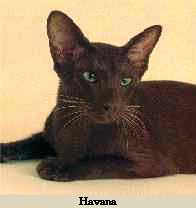 Eye Colour: Clear, bright vivid green with no flecks of contrasting colour.
Eye Colour: Clear, bright vivid green with no flecks of contrasting colour.
Coat Colour: Rich warm chestnut brown. Not dark or cold toned.
Nose Leather & Eye Rims: Brown or pinkish-brown.
Paw Pads: Solid brown or solid pinkish-brown.
Withhold Certificates or First Prizes in Kitten Open Classes for:
ORIENTAL LILAC (29c) (Championship status)
Eye Colour: Clear, bright, vivid green with no flecks of contrasting colour
Coat Colour: Frosty grey with a distinct pinkish tone, giving an overall appearance of lilac. Colour too blue or too fawn is a fault.
Nose Leather & Eye Rims: Pinkish lilac.
Paw Pads: Solid pinkish lilac.
Withhold Certificates or First Prizes in Kitten Open Classes for:
ORIENTAL BLACK (37) (Championship status)
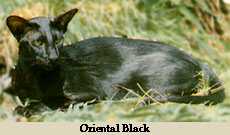 Eye Colour: Green with no flecks of contrasting colour.
Eye Colour: Green with no flecks of contrasting colour.
Coat Colour: Jet black to the roots. No rusty tinge in adults. No white hairs.
Nose Leather & Eye Rims: Solid black.
Paw Pads: Solid black or solid brown.
Withhold Certificates or First Prizes in Kitten Open Classes for:
ORIENTAL BLUE (37a) (Championship status)
Eye Colour: Green with no flecks of contrasting colour.
Coat Colour: Light to medium blue to the roots. Free from silvery tipping. No white hairs.
Nose Leather & Eye Rims: Solid blue.
Paw Pads: Solid blue in adults. Pinkish blue allowable in kittens.
Withhold Certificates or First Prizes in Kitten Open Classes for:
ORIENTAL RED (37d) (Championship status)
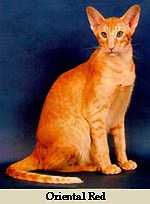 Eye Colour: Any shade of green, the more vivid the better, with no flecks of contrasting colour.
Eye Colour: Any shade of green, the more vivid the better, with no flecks of contrasting colour.
Coat Colour: Rich warm red, level in colour. Tabby markings may be evident, especially in kittens, and should not penalise an otherwise good cat. Hair red to the roots. No white hairs.
Nose Leather, Eye Rims & Paw Pads: Pink.
Note: "Freckles" may appear on nose, pads, lips, eye rims and ears. Slight freckling in a mature cat should not be penalised.
Withhold Certificates or First Prizes in Kitten Open Classes for:
ORIENTAL CREAM (37f) (Championship status)
Eye Colour: Any shade of green, the more vivid the better, with no flecks of contrasting colour.
Coat Colour: Cool toned cream, level in colour. Tabby markings may be evident, especially in kittens, and should not penalise an otherwise good cat. Hair cream to the roots. No white hairs.
Nose Leather, Eye Rims & Paw Pads: Pink.
Note: "Freckles" may appear on nose, pads, lips, eye rims and ears. Slight freckling in a mature cat should not be penalised.
Withhold Certificates or First Prizes in Kitten Open Classes for:
ORIENTAL APRICOT (37fn) (Championship status)
Eye Colour: Any shade of green, the more vivid the better, with no flecks of contrasting colour.
Coat Colour: Apricot intense in tone with a slightly darker dusting which becomes more noticeable with maturity. Tabby markings may be evident, especially in kittens, and should not penalise an otherwise good cat. Mature cats may show a metallic sheen on these tabby markings.
Nose Leather, Eye Rims & Paw Pads: Pink.
Note: "Freckles" may appear on nose, pads, lips, eye rims and ears. Slight freckling in a mature cat should not be penalised.
Withhold Certificates or First Prizes in Kitten Open Classes for:
ORIENTAL CINNAMON (37k) (Championship status)
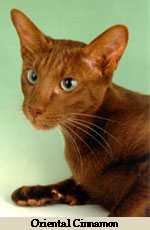 Eye Colour: Green with no flecks of contrasting colour.
Eye Colour: Green with no flecks of contrasting colour.
Coat Colour: Warm cinnamon brown, coloured to the roots. No white hairs.
Nose Leather & Eye Rims: Cinnamon brown.
Paw Pads: Pink to cinnamon brown.
Withhold Certificates or First Prizes in Kitten Open Classes for:
ORIENTAL CARAMEL (37n) (Championship status)
Eye Colour: Green with no flecks of contrasting colour.
Coat Colour: Dark brownish grey (for blue based) or a warmer brownish grey (for lilac/fawn based), coloured to the roots. No white hairs. All caramels should display a metallic sheen irrespective of their colour base, but it may be less evident in kittens.
Nose Leather, Eye Rims & Paw Pads: Browish grey.
Withhold Certificates or First Prizes in Kitten Open Classes for:
ORIENTAL FAWN (37r) (Championship status)
Eye Colour: Green with no flecks of contrasting colour.
Coat Colour: Warm rosy mushroom, coloured to the roots. The pinker the better, colour too blue or cold is a fault. No white hairs.
Nose Leather, Eye Rims & Paw Pads: Pinkish fawn.
Withhold Certificates or First Prizes in Kitten Open Classes for:
SCALE OF POINTS FOR ALL SELF COLOURS (except the Foreign White)
| Type (50) see general Oriental standard | 50 | |
| Colour & Coat (50) | ||
| Eye Colour | 15 | |
| Coat Colour | 30 | |
| Coat Texture | 5 | |
| Total | 100 | |
ORIENTAL NON-SELFS OTHER THAN TABBIES
ORIENTAL TORTOISESHELLS (Championship status)
Eye Colour: Green with no flecks of contrasting colour.
Coat Colour: The base colour in all Oriental Torties should be coloured to the roots and free from tabby markings. This base colour is patched and/or mingled at random with shades of red/cream/apricot which may show tabby markings. The head, body, tail and all four legs need not be evenly patterned but all must show some break in colour. Presence or absence of a blaze is immaterial.
Nose Leather, Eye Rims & Paw Pads: Plain or patched, in accordance with the base colour and/or pink.
ORIENTAL TORTIE (BLACK) (37e): Jet black with shades of dark and/or light red.
BLUE ORIENTAL TORTIE (37g): Light to medium blue with shades of cream and/or pale cream.
CHOCOLATE ORIENTAL TORTIE (37h): Rich warm chestnut brown with shades of dark and/or light red.
LILAC ORIENTAL TORTIE (37j): Frosty grey with a distinct pinky tone with shades of cream and/or pale cream.
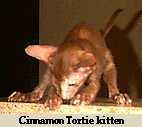 CINNAMON ORIENTAL TORTIE (37m): Warm cinnamon brown with shades of dark and/or light red.
CINNAMON ORIENTAL TORTIE (37m): Warm cinnamon brown with shades of dark and/or light red.
CARAMEL ORIENTAL TORTIE (37p): Dark brownish grey (for blue based) or a warmer brownish grey (for lilac/fawn based) with shades of apricot, showing a metallic sheen.
FAWN ORIENTAL TORTIE (37y): Warm rosy mushroom with shades of rich and/or paler cream.
Withhold Certificates or First Prizes in Kitten Open Classes for:
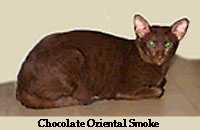 ORIENTAL SMOKE (42 - 42y) (Championship status)
ORIENTAL SMOKE (42 - 42y) (Championship status)
Eye Colour: Green with no flecks of contrasting colour. In Red, Cream and Apricot Smokes the eye colour may be less intense.
Coat Colour: Any of the Oriental Self or Tortie colours with a near-white undercoat, which should be approximately one third to two thirds of the total hair length in adults. The degree of contrast on the head and face should match the body as closely as possible and too much silver giving the appearance of clear tabby markings is undesirable. In dilute colours the contrast may be less obvious but the undercoat must be silver. The silver gene may modufy the colour resulting in a colder or darker shade than in the self or tortie equivalent, and this should not be penalised. Some faint ghost tabby markings may be evident on the body, especially in kittens, but distinct tabby markings in adults are undesirable. In Red, Cream, Apricot and Tortie Smokes tabby markings may be more evident, especially in kittens, and should not penalise an otherwise good cat.
Nose Leather, Eye Rims & Paw Pads: As in the equivalent Self or Tortie colour.
Withhold Certificates or First Prizes in Kitten Open Classes for:
SCALE OF POINTS FOR ORIENTAL TORTIES AND SMOKES
| Type (50) see general Oriental standard | 50 | |
| Colour & Coat (50) | ||
| Eye Colour | 15 | |
| Coat Colour & Pattern | 30
| |
| Coat Texture | 5
| |
| Total | 100 | |
ORIENTAL SHADED (43 - 43ys) (Championship status)
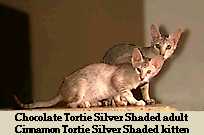 Eye Colour: Green with no flecks of contrasting colour. In Red, Cream and Apricot Shaded
the eye colour may be less intense.
Eye Colour: Green with no flecks of contrasting colour. In Red, Cream and Apricot Shaded
the eye colour may be less intense.
Pattern: The Oriental Shaded is an agouti cat in which the dark shading colour is restricted to the surface of the coat. A shaded is differentiated from a poor Ornetal Tabby by the presence of a clear paler under-colour, free from agouti banding or ticking, extending at least two thirds up the hair shaft on the sides in adults. Some cats may show heavier shading on the spine line, which is permissible, and may show some residual surface pattern.
The tabby pattern, which may be Ticked, Spotted, Mackerel or Classic, may show clearly on the surface of the coat in kittens becoming less distinct as the lighter under-colour extends up the hair shaft with maturity. Classic based Shadeds may appear darker because the pattern area is greater. The head, legs and tail may show some tabby markings of varying clarity depending on the degree of shading.
The coat may be shaded or tipped with any of the Oriental Self or Tortie colours. The shading colour should be the same as the pattern area of the equivalent Oriental Tabby. The undercolour should be slightly paler than the ground colour in the equivalent Oriental Tabby since there should be no agouti banding, but should not lack any warmth required by the description. The silver gene may modify the shading colour, resulting in a colder or darker shade than in the standard equivalent and this should not be penalised. Tarnishing, i.e. discolouration of the silver, is undesirable.
Nose Leather, Eye Rims & Paw Pads: As in the equivalent colour of Oriental Tabby.
Withhold Certificates or First Prizes in Kitten Open Classes for:
SCALE OF POINTS FOR ORIENTAL SHADEDS
| Type (50) see general Oriental standard | 50 | |
| Colour & Coat (50) | ||
| Eye Colour | 10 | |
| Coat Colour & Pattern | 35
| |
| Coat Texture | 5
| |
| Total | 100 | |
ORIENTAL TABBIES
ORIENTAL SPOTTED TABBY (38 - 38ys) (Championship status)
ORIENTAL CLASSIC TABBY (41 - 41ys) (Championship status)
ORIENTAL MACKEREL TABBY (44 - 44ys) (Championship status)
ORIENTAL TICKED TABBY (45 - 45ys) (Championship status)
General: The tabby pattern is formed by markings of the solid pattern colour on a background of agouti hairs. The pattern colour in Standard Tabbies should be that of the equivalent coloured Oriental Self or Tortie. The silver gene may modify the shading colour, resulting in a colder or darker shade than in the standard equivalent and this should not be penalised. The pattern colour in Spotted, Classic and Mackerel Tabbies should match on head, body, legs and tail. There should be no speckling of agouti hairs in the markings and a pattern which consists of dark agouti on a light agouti background is incorrect and must be penalised. In Ticked Tabbies the pattern colour on head, legs and tail should match the ticking colour on the body.
In Standard Tabbies the markings should be dense to the roots and in Silver Tabbies they should extend well down the hair. The markings should show good contrast with the ground colour but in dilute colours the contrast between the markings and the ground colour is less than that required in non-dilute colours. In Tortie Tabbies the distribution of tortie markings is immaterial.
In Silver Tabbies tarnishing, i.e. discolouration of the silver ground colour, is undesirable.
Head Markings: On the forehead there should be a letter "M" extending to form a beetle shaped "scarab" marking running back between the ears. There should be unbroken lines running from the outer corners of the eyes and there should be pencillings on the cheeks. Thumb prints on the ears are desirable. In Ticked Tabbies the head markings may be reduced in intensity and/or extent or absent. The Oriental Tabby has a tendency to white in the immediate area of the lips and lower jaw. It is a serious fault if this extends to the throat and/or muzzle in Standard Tabbies but silvery white colour on the throat and/or muzzle in Silver Tabbies is not a fault.
Leg Markings: The legs should be barred in Classic and Mackerel Tabbies, barred and/or spotted in Spotted Tabbies. The barring should extend from the body marking to the toes. In Ticked Tabbies the bars may be reduced in intensity and/or extent or absent. The pattern colour should extend well up the back of the hind legs.
Tail Markings: Ringed in Spotted and Mackerel Tabbies, wider rings in Classic Tabbies. In Ticked Tabbies the rings may be reduced in intensity and/or extent or absent. There should be a solid tip of the pattern colour except in Red, Cream and Apricot tabbies where the tip may be pale.
Spotted Pattern: On the neck and upper chest there should be broken or unbroken necklaces, the more the better.
Lines running from the top of the head down the back of the neck should break into spots on the shoulders and along
the spine. Kittens may show a rather solid spine line but evidence of breaking into spots is desirable.
A solid spine line in adult cats is a serious fault. The spots may vary in size but should be round and evenly distributed.
Spots should not run together into a broken Mackerel striped pattern in any part of the coat.
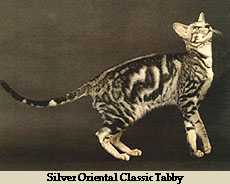 Classic Pattern: On the neck and upper chest there should be unbroken necklaces, the more the better.
One of the lines running from the top of the head down the back of the neck should extend to the shoulder markings
which should be shaped like a butterfly when viewed from above; both upper and lower wings should be clearly defined
in outline with dots inside this outline. On the back there should be a line running down the spine from the butterfly
to the tail and there should be a stripe on each side of this, running parallel to it. These three stripes should be
separated from each other by stripes of the ground colour. On each flank there should be a large solid oyster or blotch,
which should be surrounded by one or more unbroken rings. The ground colour and markings should be evenly balanced except
on the belly which should be predominantly lighter with spotted markings.
The markings on each side should match as closely as possible.
Classic Pattern: On the neck and upper chest there should be unbroken necklaces, the more the better.
One of the lines running from the top of the head down the back of the neck should extend to the shoulder markings
which should be shaped like a butterfly when viewed from above; both upper and lower wings should be clearly defined
in outline with dots inside this outline. On the back there should be a line running down the spine from the butterfly
to the tail and there should be a stripe on each side of this, running parallel to it. These three stripes should be
separated from each other by stripes of the ground colour. On each flank there should be a large solid oyster or blotch,
which should be surrounded by one or more unbroken rings. The ground colour and markings should be evenly balanced except
on the belly which should be predominantly lighter with spotted markings.
The markings on each side should match as closely as possible.
Mackerel Pattern: On the neck and upper chest there should be unbroken necklaces, the more the better.
One of the lines running from the top of the head down the back of the neck should extend as a narrow unbroken line
to the base of the tail. On either side of this should be a broken spine line from which the narrow lines which form
the Mackerel Pattern run vertically down the body; these lines should be as narrow and numerous as possible.
Ground colour and markings should be evenly balanced.
Ticked Pattern: On the neck and upper chest there may be a necklace, broken or unbroken. The body should be free from spots, stripes or blotches, except for darker dorsal shading. The lighter belly may show tabby markings. The coat should be evenly ticked with the pattern colour, with double, or preferably treble, ticking. i.e. two or three bands of each colour on each hair.
COLOUR DESCRIPTION FOR ALL TABBY PATTERNS
Eye Colour: Green with no flecks of contrasting colour. In Red and Cream Tabbies the eye colour may be less intense.
Nose Leather: As in the equivalent self or tortie colour or pink rimmed with the self or tortie colour.
Eye Rims & Paw Pads: As in the equivalent self or tortie colour.
Note: In Red and Cream Tabbies "Freckles" may appear on nose, pads, lips, eye rims and ears.
Slight freckling in a mature cat should not be penalised.
Coat Colour:
BROWN: Markings jet black. Ground warm coppery brown.
BLUE: Markings light to medium blue. Ground cool beige.
CHOCOLATE: Markings rich warm chestnut brown. Ground warm bronze.
LILAC: Markings frosty grey with a distinct pinkish tone. Ground beige.
RED: Markings rich warm red. Ground paler bright red.
BLACK TORTIE: Markings jet black with red. Ground warm coppery brown with pale red.
CREAM: Markings cool toned cream. Ground paler cream.
APRICOT: Markings apricot intense in tone with a slightly darker dusting that becomes more noticeable with maturity. Mature cats may show a metallic sheen. Ground pale apricot.
BLUE TORTIE: Markings light to medium blue with cream. Ground cool beige with pale cream.
CHOCOLATE TORTIE: Markings rich warm chestnut brown with red. Ground warm bronze with pale red.
LILAC TORTIE: Markings frosty grey with a distinct pinkish tone with cream. Ground beige with pale cream.
CINNAMON: Markings warm cinnamon brown. Ground warm light cinnamon.
CINNAMON TORTIE: Markings warm cinnamon brown with red. Ground warm light cinnamon with pale red.
CARAMEL: Markings dark browish grey (for blue based) or a warmer brownish grey (for lilac/fawn based) with a metallic sheen. Ground beige.
CARAMEL TORTIE: Markings dark browish grey (for blue based) or a warmer brownish grey (for lilac/fawn based) with a metallic sheen with apricot. Ground beige with pale apricot.
FAWN: Markings warm rosy mushroom. Ground warm pale mushroom.
FAWN TORTIE: Markings warm rosy mushroom with rich cream. Ground warm pale mushroom with pale cream.
BLACK SILVER: Markings black. Ground silver.
BLUE SILVER: Markings blue. Ground pale blue-silver.
CHOCOLATE SILVER: Markings chocolate. Ground pale chocolate-silver.
LILAC SILVER: Markings lilac. Ground pale lilac- silver.
RED SILVER: Markings red. Ground pale red-silver.
BLACK TORTIE SILVER: Markings black with red. Ground silver with pale red-silver.
CREAM SILVER: Markings cream. Ground pale cream-silver.
APRICOT SILVER: Markings apricot intense in tone with a slightly darker dusting that becomes more noticeable with maturity. Mature cats may show a metallic sheen. Ground pale apricot-silver.
BLUE TORTIE SILVER: Markings blue with cream. Ground pale blue-silver with pale cream-silver.
CHOCOLATE TORTIE SILVER: Markings chocolate with red. Ground pale chocolate-silver with pale red-silver.
LILAC TORTIE SILVER: Markings lilac with cream. Ground pale lilac- silver with pale cream-silver.
CINNAMON SILVER: Markings cinnamon. Ground pale cinnamon-silver.
CINNAMON TORTIE SILVER: Markings cinnamon with red. Ground pale cinnamon-silver with pale red-silver.
CARAMEL SILVER: Markings dark browish grey (for blue based) or a warmer brownish grey (for lilac/fawn based) with a metallic sheen. Ground pale beige-silver.
CARAMEL TORTIE SILVER: Markings dark browish grey (for blue based) or a warmer brownish grey (for lilac/fawn based) with a metallic sheen with apricot. Ground pale beige-silver with pale apricot-silver.
FAWN SILVER: Markings mushroom. Ground pale mushroom-silver.
FAWN TORTIE SILVER: Markings mushroom with cream. Ground pale mushroom-silver with pale cream-silver.
SCALE OF POINTS FOR ALL ORIENTAL TABBIES
| Type (50) see general Oriental standard | 50 | |
| Colour & Coat (50) | ||
| Eye Colour | 10 | |
| Coat Colour (pattern & ground) | 15 | |
| Pattern Shape & Clarity | 20 | |
| Coat Texture | 5 | |
| Total | 100 | |
WITHHOLDING FAULTS FOR ALL ORIENTAL TABBIES
Withhold Certificates or First Prizes in Kitten Open Classes for:
|
| These pages were brought up to date from the original by Julia May which is still accessible here:- |
Copyright, including logo, © 1997 - 2013 Oriental Joint Breed Advisory Committee. All rights reserved.